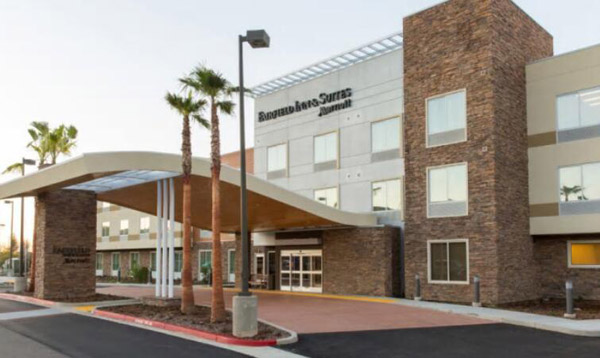
The new Fairfield Inn and Suites in Folsom, California–a Sacramento suburb–flaunts the familiar normcore-chic style we’ve come to expect from budget and midrange hotels: funky contemporary furniture, vibrant accent walls, graphic carpets, and mood lighting. It’s a look that assures customers they’re getting a clean and comfy room, not the Bates Motel, and it’s virtually indistinguishable from its brethren. But dig a little deeper, and the hotel starts to get interesting: It’s the first factory-built hotel from the Marriott brand in the country.
Marriott, the world’s largest hospitality company, is betting that modular prefabs are the future of hotels in North America, and it is making this construction technique a central component of its business strategy. The company hopes prefab will help it build hotels faster, more affordably, and at a quality that exceeds traditional methods. It’s currently building its second modular hotel in Oklahoma City, recently signed on to build one in Hawthorne, California, and expects to ink deals for 50 more prefabs in 2017.
“We looked at our growing pipeline and asked ourselves, ‘How do we waste less materials? How do we get these hotels to look great?” Karim Khalifa, vice president of global design at Marriott, tells Co.Design.
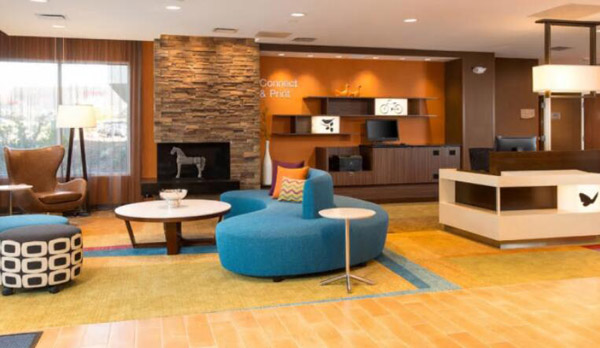
While modular design has become widely accepted abroad and is used for a variety of building types–residential, commercial, hospitality–it’s experienced a slower uptake in the United States. Single- and multi-family housing has been the main focus of American prefab developers; hospitality has lagged behind due to lack of demand. But as the American prefab industry as a whole is maturing, hotel companies are catching on.
There are a few one-off modular hotels in the country, and the industry has experienced double-digit growth in the past couple years, according to Building Design + Construction; however, Marriott, as the United States’ largest operator of select-service hotels, getting into the game suggests?that prefab is poised to move from novelty to?convention. However, as other large-scale, high-profile prefab initiatives have shown, it’s likely to be a rocky road ahead, and the returns might not be as grand as developers hope.
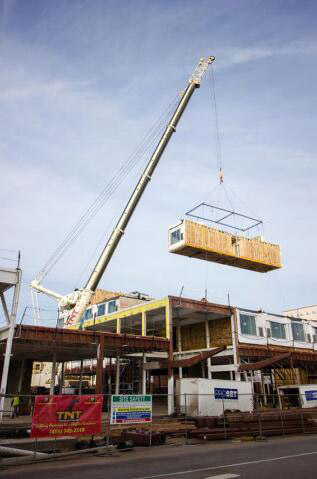
Oklahoma City AC Hotel [Photo: courtesy Marriott]
The appeal of prefab to Marriott centers around three areas: speed and ease of construction over the lifetime of a hotel, quality, and cost-effectiveness/profitability. The arguments for prefab categorically–building in a factory offers more control and consistency than on site, uses less material, and is faster since climactic conditions don’t impact construction–convinced Marriott that it was the sensible way to go. Plus, the company’s business model (it strives for consistency throughout its properties) and scale (it operates more than 6,000 hotels across 120 countries) are suited to a more mechanized approach to building.
Here’s how a hotel is typically built: the foundation is poured, the framing is erected, then the various trades–electrical, plumbing, ventilation, carpentry–do their work one at a time. Because their primary concern is doing the task at hand, not the building as a whole, irregularities occur. In one room, the electrical conduits might be higher than in another room, someone might lay pipe where an HVAC eventually needs to go, so the HVAC people have to retool. The work has to happen quickly and because the site is large, it’s challenging to supervise. Mistakes are made and not everything is caught.
While prefab isn’t foolproof, factories often cross-train their employees on the entire process of building a module. “Workers have a better idea of the full picture of what they’re trying to do,” Khalifa says. “It’s leveraging skill and cross-training.”
Most of the guest rooms in its select-service brands–Courtyard, Fairfield Inn, Four Points, Aloft–are roughly the same size, about 12-feet-by-24-feet large. This is well suited to serial production. While the actual furnishings and finishes can change from brand to brand, the bones don’t have to. According to Khalifa, this helps with quality control.
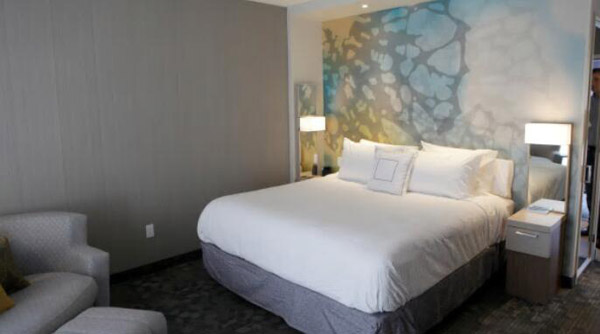
Courtyard Hotel [Photo: courtesy Marriott]
“The [factory] workers are conducting all their processes in the most physically advantageous ways to do a skill,” he says. “In the field, they don’t get to do that. So they learn how to do things well and cleanly, and supervisors can oversee every task. When you have people running up and down [a construction site] you miss pieces.” (Since Marriott doesn’t develop the hotels themselves, they don’t have an estimate on how much construction site overruns have cost over the years.)
Moreover, because prefab is more consistent–there’s documentation about where electrical wiring is placed, where plumbing is located, and where ventilation is–it’s easier to renovate modular rooms over time since there’s no guesswork, Khalifa argues.
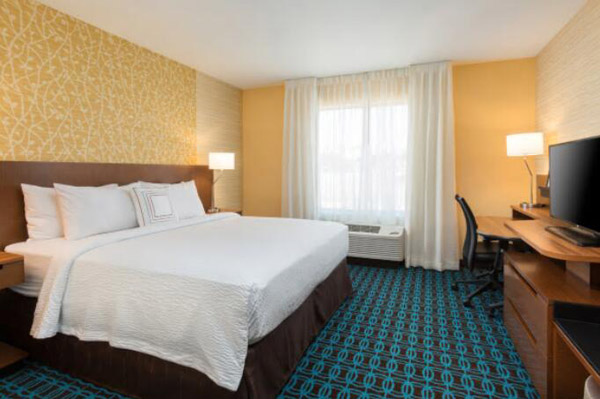
Fairfield Inn and Suites in Folsom, California [Photo: courtesy Marriott]
Marriott expects finishes to be more accurate in prefab hotels, and for there to be better insulation, which helps reduce sound transmission–the biggest?guest complaint. In a typical stick-built Marriott project, about 5% to 6% of total materials become construction waste; with prefab, it was about 2% to 3%, according to the company.
But beyond speed and environmental considerations, what was most convincing to the company had to do with consequences from the recession in the aughts.
“We’ve seen a lack of high-quality subcontractors after the financial crisis,” Eric Jacobs, chief development officer for Marriott in North America, says. “Contractors and subcontractors left the industry and didn’t come back. What we’re struggling with is a labor shortage and a shortage of quality craftsmen and women who do finished work. The commercial real-estate industry is stretched thin right now.”
The construction industry as a whole is experiencing a labor shortage right as we’re experiencing a building boom. The Bureau of Labor Statistics estimates there are 150,000 unfilled construction jobs in the United States, as the Wall Street Journal reports. Associated General Contractors of America found that 73% of companies had a difficult time finding qualified workers. At the same time, schools aren’t focusing on vocational programs, which is putting a damper on new construction workers entering the industry.
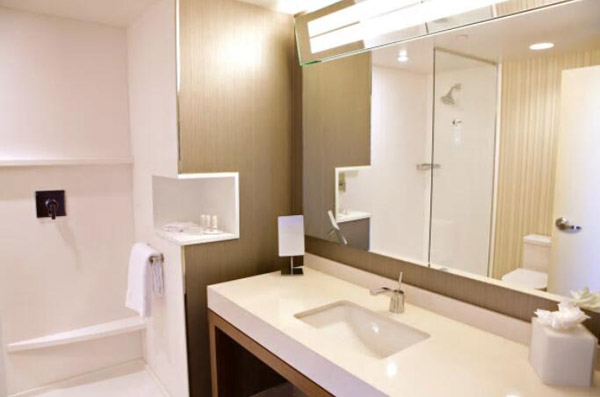
Courtyard Hotel [Photo: courtesy Marriott]
Shortening the development time and reducing the number of workers on-site were key to coping with the new realities of the construction industry. Using traditional building techniques, the average construction time for Marriott is 12 months. With prefab, it estimates that the same hotel could be built in seven months or less. Marriott expects construction costs to come down as it scales up over the next five years, but today, prefab is about even with traditional methods, according to Khalifa. However, the financial incentive for Marriott is that its prefab hotels could reach?profitability sooner–a by-product of a faster development cycle.
Despite operating thousands of hotels, Marriott doesn’t actually own real estate. It’s essentially a franchise and brand manager. According to Jacobs, about 5% of Marriott’s properties are owned by investment groups and 95% are owned and paid for by their operators, most of whom also own hotels from competing brands. (“It’s not like how you can’t own a Burger King and a McDonald’s,” Jacobs says. “In any local city, pick our brand or a competitor’s brand and the same guy owns all of that.”) By making development for the?owner-operators less expensive (eventually), offering a higher caliber of design and construction (which translates to a better guest experience), and increasing profitability potential, Marriott believes it is giving itself an edge in a competitive industry.
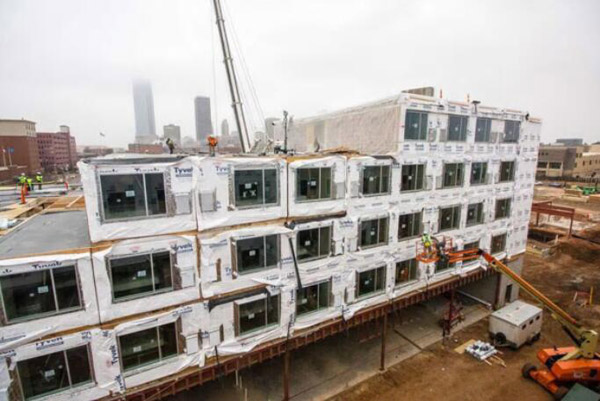
Oklahoma City AC Hotel [Photo: courtesy Marriott]
“People will invest money with brands and people they trust and who are doing the best to take care of their money,” Jacobs says. “If we’re not being a good steward and showing good investment, they’ll go with another brand. We rely on our operators to grow [our business], so we have to be thoughtful. That’s part of our strategy.”
So far, the gains have fallen short of expectations, which is not unusual. Because of a permitting holdup in Folsom–which Marriott says was unrelated to prefab construction–there were construction delays, and the process?was only two months shorter than traditional build time. It cost about $13.2 million to build using the modular process, which is the same as it would’ve?cost using traditional construction, according to Marriott. Over time, they expect the numbers to change as the volume of prefab increases, since builders will become better at constructing the modules and the modular hotel industry becomes more competitive.
While Marriott is excited about prefab and is trumpeting its benefits, the company doesn’t want the building technique itself to stand out to its guests.
“We hope guests don’t notice the construction type,” Khalifa says. “What we think they’ll notice it’s a better building overall. They won’t say, ‘Wow I love this modular hotel.’ They’ll say, ‘I love this Fairfield Inn in Folsom,’ and they might not know why, but they’ll have a great stay.”

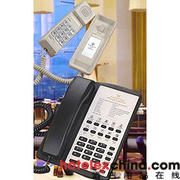
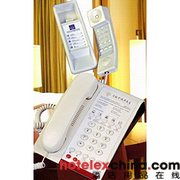


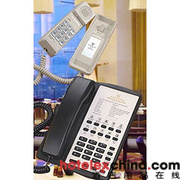


Service Hotline
Work Time:Mon-Fri 9:00-18:00
UTC+8

Sinoexpo Digital Platform
Copyright 2006-2024 Shanghai Sinoexpo Informa Markets International Exhibition Co., Ltd. All rights reserved
沪ICP备05034851号-77
 沪公网安备 31010402000543号
沪公网安备 31010402000543号